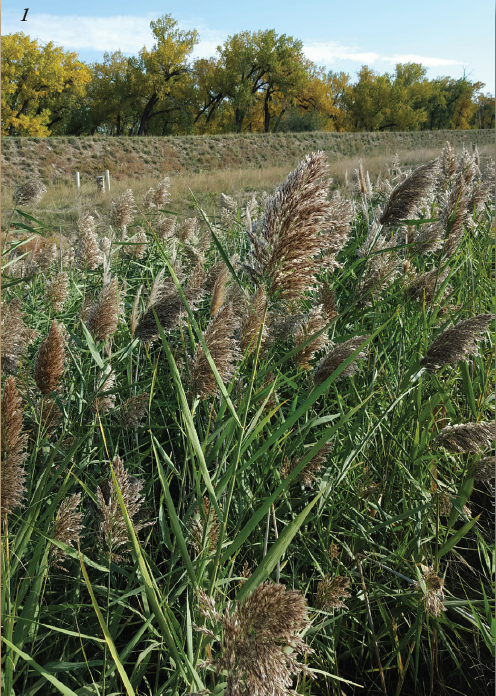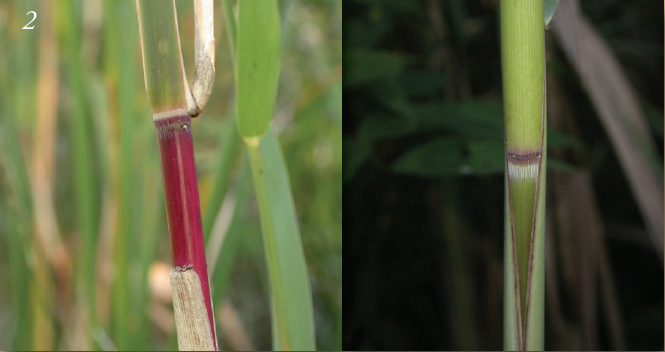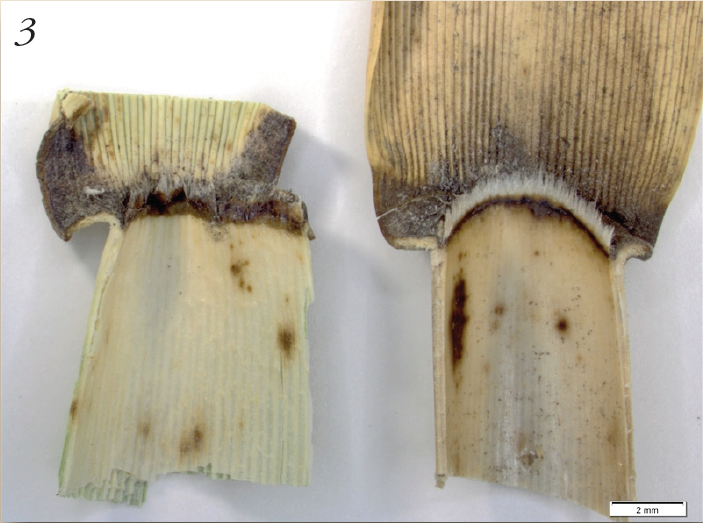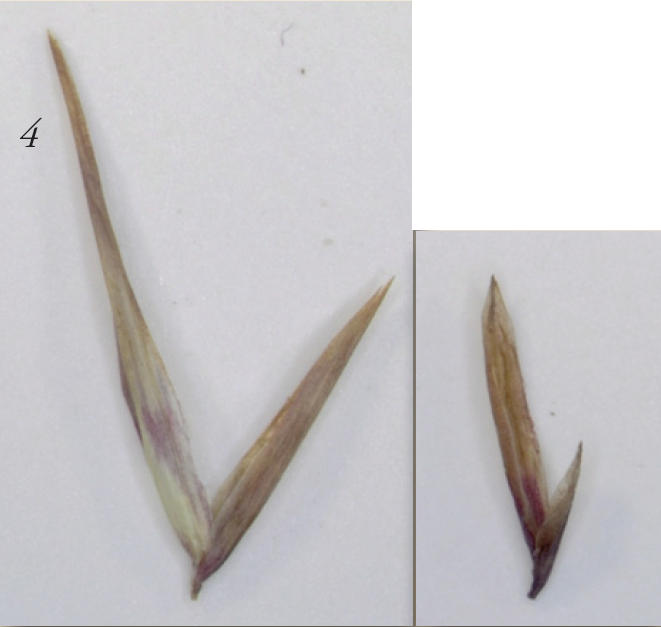Watch Out for Phragmites
An exotic subspecies of phragmites (Phragmites australis ssp. australis) was first confirmed in Montana in 2014 and added to the state noxious weed list in 2015. The purpose of this bulletin is to provide information about phragmites history, ecology, and management, and to give tips to help identify native versus exotic phragmites.
Last Updated: 01/16by Noelle Orloff and Jane Mangold, Department of Land Resources and Environmental Sciences, Montana State University
Phragmites (Phragmites australis ssp. australis) is a large-statured perennial grass that inhabits wet habitats. It is a priority 1A plant on Montana's noxious weed list. Its distribution in Montana is currently limited to sites in Blaine, Hill, and Lake Counties. Identifying this plant is challenging because it is closely related to a native variant of the same species. The subspecies native to Montana is P. australis ssp. americanus, which we will refer to as native phragmites. This publication focuses on the exotic subspecies mentioned above, which we will refer to as phragmites.
Range, habitat and impacts
Phragmites was accidentally introduced to eastern North America over 200 years ago. Due to its close resemblance to the native subspecies of phragmites it was not detected until 2002 when genetic testing confirmed that an introduced lineage was present on our continent. Phragmites is now widespread across Canada and the eastern United States, and it is becoming more prevalent along roads and waterways in the Midwest, Great Lakes region, and western United States. Wet areas are suitable habitat including marshes, sloughs, ditches, and other riparian corridors.
FIGURE 1. Phragmites has plume-like, feathery inflorescences.

Photo by T. Turner, Hill County Weed District, Montana
Phragmites has potential to impact wetlands in Montana. In other parts of the United States it has proven capable of spreading rapidly and forming dense stands. It has also formed large monocultures that have been associated with decreased plant diversity and changes in associated bird, fish, and insect habitat. Large, dense stands of phragmites may also increase sedimentation rates and alter wetland hydrology. Not only can phragmites invasion have negative impacts, but the intensive management techniques necessary to control established populations may also have negative impacts and rarely result in eradication.
Identification - Do you have the native or exotic subspecies?
Correct identification of phragmites is critical. First, early detection hinges on identification, and it is important to control this plant in the early stages of invasion. Second, native phragmites is easily mistaken for exotic phragmites, and it is a beneficial wetland plant that should not be mistakenly managed.
Phragmites is a stoloniferous or rhizomatous perennial grass that grows between six and 15 feet tall. It has large, plume-like inflorescences often with a purple or golden hue (Figure 1). It can be difficult to differentiate between exotic and native phragmites. Identification involves focusing on a combination of stem color (Figure 2), leaf sheath persistence, ligule length (Figure 3), upper and lower glume length (Figure 4), and stem density, among other sometimes useful characteristics (Table 1). Make sure to look at several characteristics in combination, as well as several individual stems within a population when investigating whether you might have exotic phragmites. When a visual assessment is not sufficient to differentiate between exotic and native phragmites, genetic testing may be needed.
FIGURE 2. Stems of native phragmites (left) are likely to be smooth, shiny, and often reddish while stems of exotic phragmites (right) are often dull green or tan with small ridges.

L. and S. Namestnik, handlensandbinoculars@blogspot.com.
Prevention and Early Control Methods
Preventing introduction to new areas is the most cost-effective management strategy for phragmites as established stands are expensive and extremely difficult to eradicate. As a first step to prevention, it is critical to be able to identify this plant so new populations can be controlled when they are still small and manageable. Seeds typically require bare ground to establish, so preventing disturbance to wetland areas is important. A vigorous perennial plant community is a good line of defense as wetlands with intact plant communities are more resistant to phragmites invasion than disturbed wetlands.
Verify that you have exotic and not native phragmites before managing any suspected populations. Not only is native phragmites a beneficial wetland species, but mistakenly controlling native species is not a good use of limited time and resources and may open space in the plant community for exotic phragmites or other unwanted plants to invade.
If you do have exotic phragmites, integrated weed management techniques including herbicides, mechanical control, and prescribed burning may limit the spread of local populations. If there is little desired vegetation at a site, revegetation should be integrated with other techniques to establish a competitive plant community that meets management objectives.
Selected references
Swearington, J. and K. Saltonstall. 2010. Phragmites field guide: distinguishing native and exotic forms of common reed (Phragmites australis) in the United States. Plant Conservation Alliance, Weeds Gone Wild. http://www.nps.gov/plants/alien/pubs/index.htm.
Acknowledgements
We would like to thank Kenny Keever, Matt Lavin, and Steve Young for their careful reviews of this publication.
FIGURE 3. Ligules of native phragmites (left), are usually greater than 1mm in length while those of exotic phragmites (right) are less than 1mm in length. Ligules of native phragmites are also more likely to be shredded, while those of exotic phragmites are more often intact.

Anton Reznicek, University of Michigan Herbarium.
FIGURE 4. Glumes of native phragmites (left) are usually larger than those of exotic phragmites (right).

Anton Reznicek, modified by Orloff nd Mangold.
TABLE 1. To distinguish exotic from native phragmites, consider several characteristics in combination, as well as several individual stems within a population. Identification can be difficult, and genetic testing may be necessary to distinguish these plants from one another.
| Characteristic | Native Phragmites | Exotic Phragmites |
| Leaf sheaths and stem color (spring and summer) (FIGURE 2) | Lower leaf sheaths easily fall off, exposing the stem beneath which may turn red from exposure to sunlight. | Lower leaf sheaths are attached tightly. When leaf sheaths are removed, the dull green or tan stems are visible. |
| Stem texture (FIGURE 2) | Generally smooth and shiny, often reddish in color. | Dull and rough with small ridges. |
| Ligule length (membrane at junction of leaf blade and sheath) (FIGURE 3) | >1.0 mm, more likely to look shredded. | <1.0 mm, more likely to be intact. |
| Glume length (bracts at base of grass spikelet; usually 2, an upper and a lower) (FIGURE 4) | Upper glume 5-11mm Lower glume >4mm | Upper glume 4.5 – 7.5 mm Lower glume <4 mm |
| Stem density and persistence | Often grows with other species, stems less persistent, stands may be less dense. | Often in monotypic stands with very high stem density, and stems more often persist to next growing season. |
If you suspect you have found exotic phragmites, contact your local Extension agent or county weed coordinator.

